Making Easter Calabrian Cuzzupe with Zia Vincenzina
P’s mother’s younger sister Vincenzina never married. She had the chance, she says, when she was around 18 — meaning her family had chosen someone for her — but she wasn’t interested. Instead, she’s become the favorite aunt of all her nieces and nephews, as far as I can tell. She travels to Australia, France, Rome, and beyond, to spend time with her brothers and sisters and their families, and she’s always the first person they come to see when they visit here.
Zia still walks to her campagna and back nearly every day — a good hour each way, mostly uphill. And she still carries back her bounty on her head, arms resting comfortably at her sides unless the load is exceptionally wide and requires balancing. As I’ve found out “pian piano” over the years, Zia is also the one who keeps the family history alive through photographs, stories, and age-old recipes.
Zia is truly a woman after my own heart.
We didn’t really bond until I was leaving for America a couple years ago, when we got to talking about a relative of theirs who had gone to America and kept in touch until the late 1950s, she said, and then the letters stopped. She thought he went to “Nuovo York,” she said — New York — until she showed me the last letter she had received from him. Postmarked Kulpmont, PA — on the same street that my brother now lives.
I did some research online, and discovered he had died not long after that last letter. But to imagine that as late as 1960, my Lithuanian grandfather (who grew up in Kulpmont) and P’s uncle could have been friends, drank at the same bar, passed each other in the post office — in Pennsylvania? Amazing.
The more deeply I dig into my and P’s roots through stories, habits, and food, the more connected I feel to this terra.
I’ve spent a lot more time with Zia since then, and I’ve learned so much of their family history that P didn’t even know. It’s always exciting to come home and share with him what I’ve learned as he loves the old tales too. Such was the case this past week when I learned the family recipe for cuzzupe, an Easter specialty around here. Recipes for cuzzupe vary greatly — this one produces a sweet somewhere between a cookie and a cake, while other types of cuzzupe are more bread-like, and you may find whole eggs baked into them as well.
The Fabio family factoid I learned this time has to do with these baking trays:
These were handmade by Zio Giacomo, who now lives in Australia, from the large tins of tomatoes, tuna, and the like — quite a long time ago, as you might imagine. Can you imagine how many cuzzupe they’ve seen?
Cuzzupe di Pasqua – Calabrian Easter Cakes
(makes about 40 loaves — feel free to cut recipe in half!)
- 10 large eggs
- 2 cups olive oil
- About a cup (un bicchiere) of lemon juice
- 1/4 cup of lemon zest, chopped finely
- 2 kilos flour*
- 1 kilo sugar
- 500 ml milk
- 2 packets of ammoniaca**
- 2 packets of vanilla
1. Preheat oven to 375°F/190°C*** and lightly grease (olive oil works well) and flour baking pans.
2. Crack eggs into large mixing bowl and beat until smooth. Stir in olive oil and lemon juice.
3. In a medium mixing bowl, mix together milk that has been warmed and sugar. Stir until sugar is dissolved.
4. Stir ammoniaca into milk mixture and watch it bubble.
5. Pour milk mixture into eggs and combine well. Stir in lemon zest.
6. Add flour a little at a time to egg mixture until it’s all combined well and batter-like. It should be slightly thicker than pancake batter.
7. Spoon cuzzupe onto baking sheets in the forms preferred (see photos for guidance).
8. Bake for 15 minutes or until golden brown. Store these in paper bags inside plastic bags, and they’ll last for quite a while — but definitely best the first day. YUM.
Recipe Notes
*Check out this handy baking conversion chart if you’re not used to kilos and such.
**If you are in Italy and perhaps other European countries, this type of rising agent is what Zia says works best with these. If you can’t find it, baking powder, or in Italy “lievito per dolci” should work too (although Zia insists “non vengono bene” (they don’t come out well) with an outward swipe of the index and middle fingers under the chin). Remember in Italy, if you use the lievito per dolci that has vaniglia, you won’t need the vanilla packets.
***Zia baked these in her forno a legna (wood-fired oven), so I have no idea what the temperature was — I’m assuming very hot. I’m sure they could be made at a lower temperature, so I’ve guesstimated on that as well as baking time– so watch your cuzzupe carefully!
Buon appetito e Buona Pasqua!

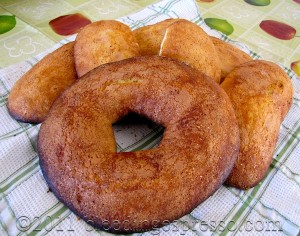
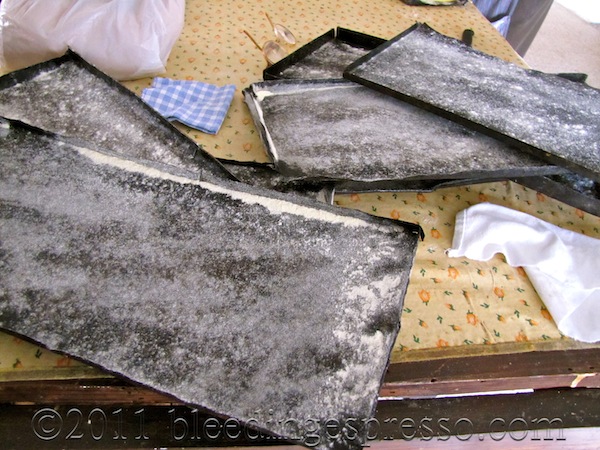
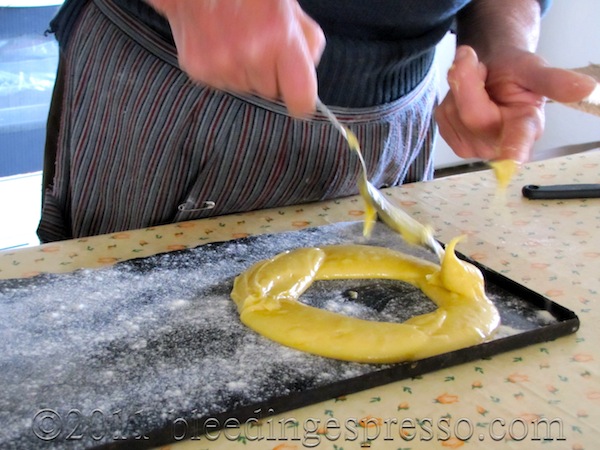
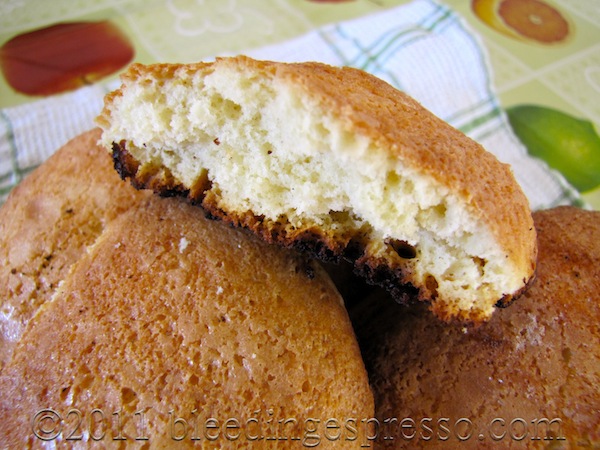
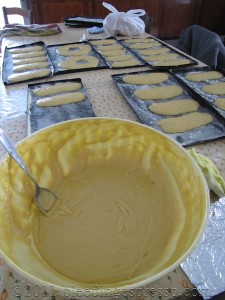
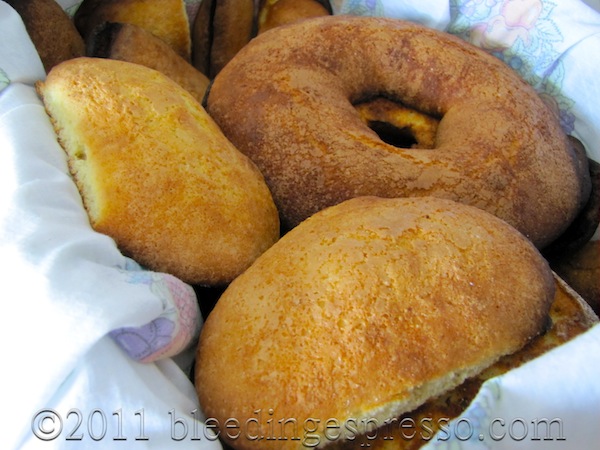












Those handmade baking sheets are really cool and the Calabrian Easter treats sound earthily delicious.
Have a wonderful Easter weekend!
Thanks Nisrine 🙂
I love the haunting story about the cousin in Kulpmont. To think that they thought about “whatever happened to old so and so” for all those years and he was already gone. I’m glad you have connected with the family historian. that will definitely help your roots spread and grow there.
I have to say, it was kind of odd to have to tell Zia of the uncle’s death…as if she didn’t realize he’d be gone by now, but still….
Loved the story of P’s relative in America and your family connection -possibly -to him. I’m a big fan of “Small world” type stories and as a matter of fact, my last blog post on Wednesday has to do with that type of thing. The recipe sounds really good and interesting too but one question -how many cups is in a kilo anyway? Remember, most of us Americans are not educated fully in the metric system -or I’ve never learned it anyway.
Jeni, there’s a link to a conversion chart in the Recipe Notes section — don’t worry, I still don’t know the conversions off the top of my head, and I’ve been here doing them for eight years!
Judith of Umbria Reply:
April 2nd, 2012 at 11:08 am
There’s no one answer, because it depends on the density of what you’ve weighed and in the case of flours, even the relative humidity that day. One cup of oatmeal doesn’t weigh the same as one cup of brown sugar or chopped almonds.
So, Michelle, better start making these or the skill will disappear with the zia. It is, after all, only once a year.
michelle Reply:
April 11th, 2012 at 1:02 pm
I do make them, Judith, and actually not just for Easter 😛
Buon Pasqua Michelle! Thanks for the lovely story about Zia Vincenzina…the more I hear about Calabrian customs the more convinced I am of how similar it is to my own family’s way of life (or at least that of my parents)…it definitely warms my heart 🙂
Thanks so much, Awedree!
What a lovely story, it sure is a small world.
Buona Pasqua Michelle
Same to you, LLM 😀
You are so fortunate to have Zia for a link with the past! As a result of my mother’s recent death I realized that I don’t know very much about my family ancestry in Norway and have done some research. One recent fact I uncovered is that a cousin of hers was a well known Hardanger fiddle player in Norway. I found a place to get a CD of his music. He also has passed away so I will never meet him but I am continuing to look for any of his students and living relatives. It’s satisfying to Google a name of someone from the past and get results! Sometimes we do not ask enough questions of our older relatives and then when they’re gone it’s so much harder to get information. The same holds true for my oldest son. I know his father (now deceased) has family living in Calabria, Reggio, I think. I will make sure my son knows all about his family history long before I am too old to tell it to him!
Good on you for taking it upon yourself, Caterina; it’s so true that as the years go on, the harder it becomes to find these family stories. Good luck!
Wow! Too much about a long lost relative of P’s being lost in your town in PA. Thanks for posting, I’ll have to show this to my wife. Buona Pasqua to you and your family.
Thanks Gil; I never know what I’m going to stumble across in this village, that’s for sure!
That sounds amazing! I always find it amusing went people realize that they’re related through experience or blood. We can’t all have long lost siblings, but it’s nice to feel like the world is a closer place sometimes.
Definitely makes you realize how small the world is, indeed…and it was even before the Internet! 😉
Thanks for responding to my email (re the get your goat expression), Michelle, and I am honored that you have posted my link on Goat Berries. Thanks too, for the link to your heartfelt “Easter” post. As I write this comment, it is the morning of Holy Saturday, and it is pouring outside. Still, I should have gone to Morning Prayer — an Easter tradition in my parish, (where, btw, we have many members from Calabria). However, I got caught up in reading through many of your former posts on Bleeding Espresso. I liked many of your entries, and I also appreciated your posting on how you happened upon the name Bleeding Espresso. I am not sure if you’ve read my posting on how my blog got its name, but, by my telling you about that particular post (included with this comment), I hope that you realize that I too, value why and how things came to be named the way they are. Meanwhile, as for your “Easter” post:
“Voicer” Nisrine M is absolutely right! Those handmade baking sheets are “cool” Awesome; in fact. Besides the fact that they are beautiful, it is wonderful to see how the “cans of tomatoes, tuna and the like” were given a new purpose in life which is also great for the environment. I am sure those sheets would sell in New York City where I live. BTW, did Zia tell you the “back story” of how they happened to make those trays? What year were they made? I am asking because I have a handful of spoons that my ancestors made from”worthless” coins, and hearing your story of the trays made me think of those spoons, and of how wonderful it was that my ancestors (and evidently yours too) made use of objects to create functional ones.
And speaking of ancestors, I also was moved by your observation that your grandfather and P’s uncle “could’ve been friends” and “drank at the same bar, passed each other in the post office . . . ”
Last year at this time, through on-line research, I too, discovered some family history, and I was able to contact the individual who was equally as thrilled to fill in the gaps of the family tree. This made me miss my departed aunt Evelyn (“Evelynia” as they called her when we traveled to Lucca, Italia), as she would probably have been thrilled that I was able to find a distant relative. I say “probably” because as typical for my father’s side of the family, Evelyn was remarkably taciturn when it came to most subjects, and therefore, I only achieved a minimal level of bonding with her — not in the way it appears you have with Zia.
I wish you a continued relationship with Zia and I look forward to the insights she provides.
Have a blessed Easter and give the kids my love. They are oh-so-cute!
Thanks so much for your comment; Zia didn’t tell me exactly when the trays were made, but I’m guessing her brother made them before he moved to Australia, and he was young when he moved, so they’ve got to be between 40 and 50 years old. I’m always happy to hear when others have made family connections — I have quite a few “taciturn” relatives as well, but thank goodness for the ones who actually want the stories to live on…may you find many more of *those* in your tree 😉
This post is profound to me. You’re right where you belong. No doubts. Amazing…
Grazie mille, Darla 🙂
These sound delicious – as does most anything with that much fresh lemon! What I found even more interesting is that you too have a Lithuanian grandfather, as I did. Mine was a coal miner in Hazelton and died of black lung at age 53. That grandfather drank in a bar owned by my Irish grandparents. There was no love lost between the two sides of my family in those days!
My grandfather had Black Lung as well, as did my great-grandfather — Hazleton isn’t too far from my hometown at all; thanks for coming by, Maureen!
Buona Pasqua, Michelle. I have enjoyed your blog for some time now, and I decided to take today and tell you. Bravissima! I have always found your posts both inspiring and a pleasure to read, and the accompanying photographs dazzle. My relatives came to Nuovo York from Abruzzo in the early years of the twentieth century, and I give thanks every day for the things I learned from my grandmother Angela Barra Crocetti and my grandfather Gaetano Crocetti that have enabled me to carry on my family’s traditions across the generations. Thank you for your very lovely blog.
Thanks so much for stopping by and taking the time to comment; truly appreciated!
Very interesting story and those cakes look divine. I will be back to get the recipe. Love Linda x
Hope you enjoy it, Linda! Thanks for coming by 🙂
Such a small world! And love the baking sheets.
Thank you! Always nice to “see” you here 🙂
My grandmother, from calabria, had 2 marriages arranged for her here in the u.s. – neither of which suited her unfortunately. The research is interesting: through the Ellis Island website I found when my grandfather came to the u.s. from nicastro and who he was with and where he went – he ended up in pittsburgh with my grandma.
That was a nice story – the world is often smaller than we would think, eh? Or there are strange coincidences with people you encounter.
Thanks for stopping by, Joe!
I love a good “small world” story. It truly never ceases to amaze me how many little coincidences there are. My cousin and her husband saw a guy wearing a Yuengling jacket while they were on a boat in Europe for their honeymoon. They talked to the guy, and it turns out he was from the same area as them, in fact, he worked for the husband’s father. I almost couldn’t believe it.
And those home-made baking sheets are incredible! I can’t believe how long they’ve lasted and how many cuzzepe they’ve made.
Haha…I’m from 20 minutes away from Yuengling 🙂
Beautiful post, Michelle. Love the photos especially. Also nice that you and Zia have bonded so well. She sounds like a warm and friendly person. As always, the photos are beautiful! Might have to make this recipe sometime… although it will need to be halved, for sure!
Thanks, and yes, I’ll be halving it the next time I make it as well…I have so many cuzzupe in the freezer!
The photographs looks so yummy:)
Thanks Istria!
I received my Calabria tour book! Thanks so much. There are some jewels in there for sure but I agree with what you said about their handling of Catanzaro.
Hopefully they’ll add some pages to the next edition 🙂
Those sweet breads are lovely.Thank You for preserving the culture by writing and taking photographs.Newer generations will have to be surprise how its done in the older days.
Thanks!
I was just browsing through your website, great photos and wonderful recipes!! Your pasta dishes look amazing 🙂 I love the way you use eggs.
michelle Reply:
August 26th, 2011 at 11:07 am
Thanks! We eat a lot of eggs to keep up with our hens hahaha 🙂
Lovely post Michelle… those baking sheets are awesome although I can’t help but worry about toxicity – wonder if there was any lead in those? Anyway, Andrea might really like this bread so I’ll give it a shot. Definitely going to cut it in half though! 🙂 Thanks!
michelle Reply:
April 11th, 2012 at 1:01 pm
Well I’ve never had them tested, but considering the whole neighborhood and family has been eating things baked on them for probably 50 years, they seem to be fine 😉